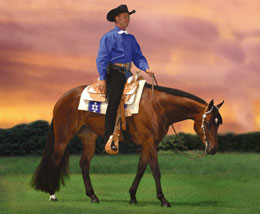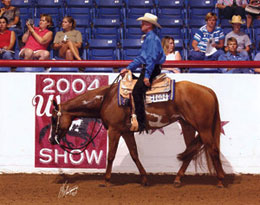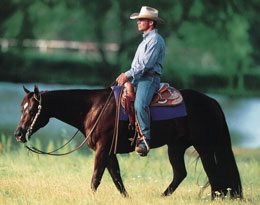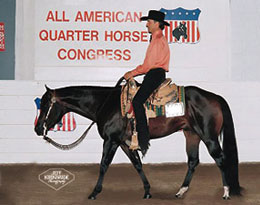When AQHA Calls
By Marilyn Morris-Mayer – Reprinted with permission from the Equine Chronicle
You can be sure of one thing…when the American Quarter Horse Association calls, its members never fail to answer.
When AQHA sent out invitations to the top western pleasure people in the country last December (selecting the top 10 riders from open Western Pleasure at the last three AQHA World Shows and the top 100 riders from the NSBA), close to 70 of those men and women managed to put their holiday plans on hold momentarily (and reaching into their own pockets for transportation and lodging costs) boarded a plane or filled the gas tank and headed to Amarillo, Texas for a two-day conference December 21-22, 2007.
A team of judges who specialize in western pleasure also was on hand along with top level AQHA and NSBA officials, and what resulted at that meeting hopefully will pave the way for even better communication, better horse shows and better horses for our industry.
Tops on the list, the American Quarter Horse Association, in conjunction with the National Snaffle Bit Association, is seeking to set the standard for what a pleasure horse should be, and with that in mind they will be producing a video to illustrate what is below average, what is average, and what is above average when it comes to a good western pleasure horse. Although AQHA has addressed this issue in the past, and did produce a video to that effect a few years back, several of the professional trainers at the meeting say this is the first time that they have been invited as a group to come and give their views and input…and take such an active role in the endeavor.
All eyes on western pleasure
It was clear to most at the meeting that the purpose of the new video would be to point out the positive aspects of today’s western pleasure horse and to educate the judges, the public and the up-and-coming trainers and riders on those qualities…while at the same time making note of the less desirable ways of going of some of the horses that are being shown in the western pleasure pen.
For sure, western pleasure draws its share of concern. It seems that critics of western pleasure pop up just about everywhere. You can find them in the “letters to the editor” column in some horse magazines; you’ll hear negative comments from some folks who are sitting in the stands or hanging on the rail at various shows; and from time to time, letters of complaint find their way to the AQHA headquarters. So just who is doing the complaining? Where are most of the complaints coming from? And why?
As to what part of the country–what states or regions–the bulk of the complaints come from, a number of the professionals that attended the December meeting say they posed that question to AQHA officials, but were told that the records did not pinpoint the situations or geographic areas that drew most of the fire.
We asked a few of the attendees to give us their views on today’s western pleasure horse and the western pleasure industry in general. Here are comments from trainers Bret Parrish, of Pavo, Georgia; Ty Hornick of Jamestown, Ohio; Troy Compton, of Purcell, Oklahoma; and Cleve Wells, of Burleson, Texas.
 Bret Parrish says we’re breeding them better
Bret Parrish says we’re breeding them better
“Things change. Pleasure horses change; cars change. People in the past liked a certain type of horse–and that’s great–but the horses are not going to stay that way,” notes Bret Parrish. “As we’ve progressed, we see some things are better and some things are worse. I think we just need to educate the general public more so they understand that we have things we need to improve, but here’s what we’re trying to do…and this is what we’re looking for.”
Bret notes that they reviewed videos of past years, past decades of western pleasure, and in his view today’s top horses are better broke and better movers. And, he adds, better minded. “We’ve bred them to be better minded and just more trainable in general. But one of our weaknesses is that we’ve gotten away from our conformation somewhat, and I think that’s something we need to go back to.
One of the issues that the new AQHA/NSBA video is said to address is the issue of western pleasure horses that “bob” their heads, but Bret says it is not an issue for him. “The more talented horse (if the trainer is doing his job) isn’t going to move his head and neck as much. And I would rather a horse move his head and neck somewhat, and perform the gaits properly with his legs. That’s a personal thing. Ideally, yes, we could perform the gaits perfectly and the head and neck would stay level, but it’s very hard to achieve that.” Bret adds, “Those are the horses that win the big ones.”
As for those horses that cannot manage that feat, and may draw criticism from onlookers, Bret cautions that it doesn’t make it a bad horse. “That horse is in a different price range (than the horses that win the big shows) and maybe the person that owns that horse really loves it and enjoys it. They know that it’s not a horse that’s going to compete to be a Congress Champion or a World Champion…but they enjoy it and that’s their hobby. There’s a top-end event and a lower-end, and there’s a place for those horses.” Bret adds, “A lot of those horses go on later to do really well in All-Around events.”
 Ty Hornick views western pleasure as the heart of it all
Ty Hornick views western pleasure as the heart of it all
“Western pleasure is the most attacked class from the public for some reason,” says trainer Ty Hornick. “And (much of) the complaints are coming from people who don’t even show western pleasure.” Ty adds, “It is really the class that most people look at and evaluate and I think it’s because it is the heart of it all. You know, pleasure is where they usually start and then take them through the western riding, the trail, the horsemanship, and maybe equitation.”
“Every year the horses just keep increasing in quality. I think the trainers are better than ever and it’s more competitive than it has ever been. I think the breed is better and I think we all agree on that.”
As for folks who say the pleasure horse of old looked better, Ty takes a different view. “It’s kind of crazy to say that they’re not as good when you look back twenty years ago and they’re running around knocking their knees and their heads are straight–they don’t even look like a Quarter horse.” Ty’s advice: “Don’t criticize something you don’t know about.”
 Troy Compton sees two distinct styles of showing
Troy Compton sees two distinct styles of showing
Troy Compton notes that you will see different styles of showing western pleasure, depending on whether it is a big-money futurity or the prestigious AQHA World Show.
“I think you’ve got two extremes: you’ve got the Tom Powers Futurity and the World Show…and those are very different extremes. At the Tom Powers we can get ‘em as slow as we want to go; it’s a little short rail and they hang their heads down a little lower (which helps them get their shoulders up and stuff) and we can show them and they’re judged on how good the horse really is. When you get to the World Show, it’s going to go by the rule book–and that’s a level topline, which not every horse conforms to. But if it’s a good horse and it’s supposed to win a World Championship it should have a level topline.
As for those who criticize the western pleasure horse in general, Troy notes that half of them are just what he terms pleasure horse “bashers.” “They just complain because they can’t do it…and that’s with any sporting event; any type of competition.”
Troy says the main thing that came out of the December meeting was that the trainers were able to get together as a group and everyone had an opportunity to exchange ideas, and it united them. “There was a little heated stuff,” he admits, but adds with a laugh, “It wasn’t between AQHA and the trainers; it was between the trainers!”
 Cleve Wells reminds us that the standard of excellence is something to strive for
Cleve Wells reminds us that the standard of excellence is something to strive for
“It was the first time that we’d had a meeting of this type, so just the meeting in itself was history,” Cleve Wells notes, “…and to come and be a voice for the pleasure horse industry was big.” Cleve says one important change that was made was to change the call for a lope from “lope with forward motion” to “lope with increased stride.” It is the slight increase in stride that increases the balance of the horse, he notes.
In Cleve’s opinion, the most important thing to remember is that western pleasure is the industry’s most popular class, in part because it is an entry level class. In a statement on AQHA’s website following the meeting, AQHA Executive Director of Judges Alex Ross noted, “Western pleasure is the foundation class for nearly every other event.”
Keeping that in mind, Cleve says that all the pleasure trainers and top riders pretty much like the same type of horse. “We all agree on what a good horse is; we all agree on what they should and shouldn’t do–but that’s in a perfect world.” There are, he reminds us, far more people out there that want to ride and show in western pleasure than there are horses that can meet the association’s standard of excellence.
“People who don’t have that top performing horse should still be allowed to play,” Cleve believes. “Maybe it’s the best horse you can have; maybe it’s the best horse you can afford. Maybe in some regions of the country, as opposed to other regions, it is a good horse.” He continues, “Are we supposed to not show them because they move their head and neck a little too much? Consider that maybe they are safe horses and they make the rider feel good…and maybe the rider actually loves that horse because they raised it.”
It is Cleve’s thought that, oftentimes, those complaints come from people who don’t show western pleasure, so maybe they’re not aware of the big picture. Cleve’s sense of humor emerges as he suggests, “I would never go to a reining and complain about the way they look–I don’t have a right to, as I’m not doing it. And I would never walk over to the hunter/jumper pen and say, ‘What in the (heck) is going on over here?’ Again, I don’t have the right.”
focusonthepositive…
Bret Parrish reminds us that not everyone can have a $150-thousand dollar horse, but that doesn’t mean they’re not having a great time. “The people that have families and that go out and enjoy three or four horses on the weekends, those horses aren’t going to be perfect…but at the same time there is a need for that horse.”
For those who would criticize western pleasure, Cleve Wells suggest they focus on the positive. “If you see a bad horse in the pen, find a good one…and don’t watch the bad one. That’s what the judge is doing. He’s not focusing on the bad one, he’s finding the good ones and placing them. Somebody gets to win that day, that’s the beauty of it. They’re going to be proud of it–and they should be.”
Just around the corner
Several of the trainers who attended the AQHA/NSBA jointly-sponsored meeting last December will be getting together again in the coming months to assist in producing and refining the upcoming video that is designed to set the standard for today’s western pleasure horse and it is hoped that the finished product will be available by late summer or early fall 2008. We’ll be waiting.
June 1st, 2008 | Posted in Articles | 0 Comments

